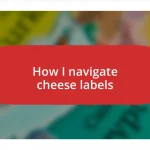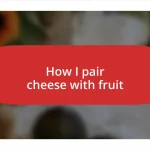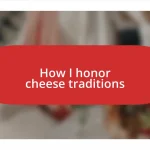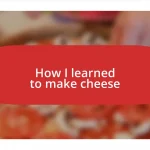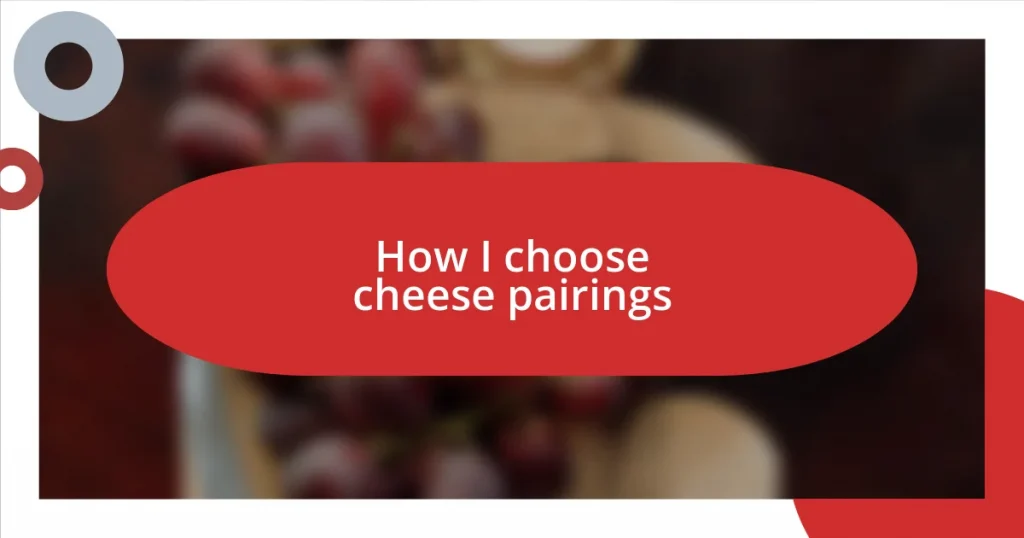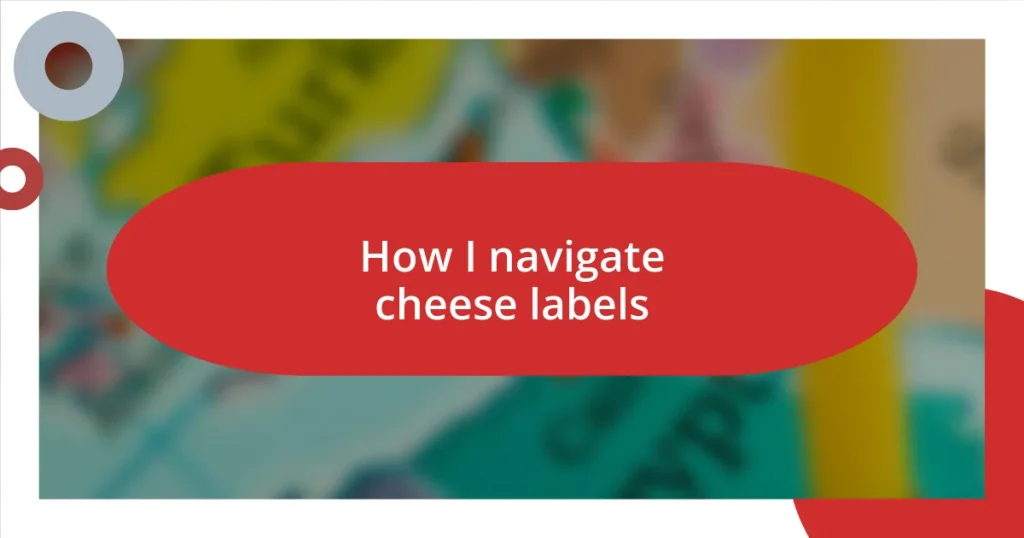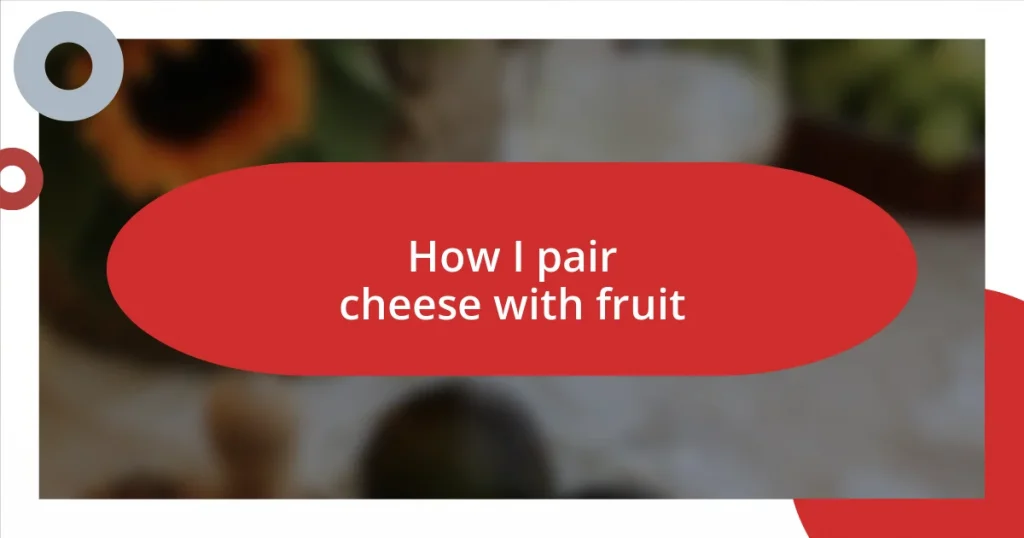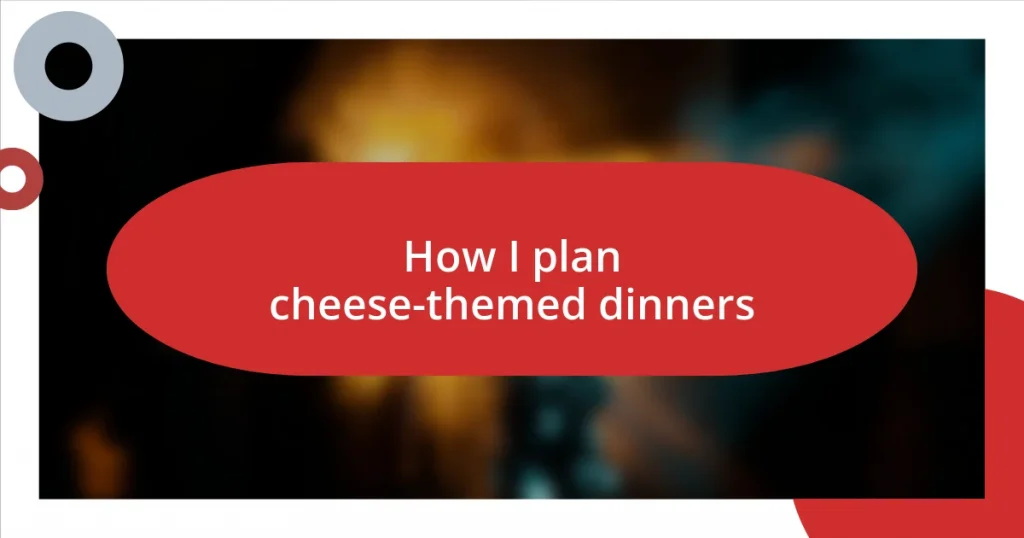Key takeaways:
- Cheese types can be categorized into fresh, aged, soft, and hard, each offering unique textures and flavors that enhance the tasting experience.
- Successful cheese pairings depend on factors like flavor intensity, texture, acidity, and personal preference, allowing for creative and enjoyable combinations.
- Seasonal ingredients and experimentation with unexpected pairings can lead to delightful discoveries, enhancing the overall enjoyment of cheese in various culinary contexts.

Understanding cheese types
When it comes to cheese, variety is truly the spice of life. I remember the first time I encountered a sharp aged cheddar compared to a creamy brie. The flavor profiles were worlds apart, yet the beauty of cheese lies in how these distinct types can complement each other. Have you ever pondered how a tangy blue cheese can elevate a simple cracker?
Cheese types generally fall into categories like fresh, aged, soft, and hard cheeses. Each type offers unique textures and flavors, shaping the taste experience. For instance, fresh cheeses like mozzarella are delicate and mild, perfect for salads, while aged varieties like Gruyère possess depth and complexity that can truly transform a dish. When I first tried pairing a strong, nutty Pecorino Romano with a bold red wine, I found a new appreciation for contrasting flavors.
Additionally, the art of cheese types extends beyond just flavor. There’s an emotional connection tied to each cheese, linked to memories of gatherings, travels, or even simple moments of indulgence. Have you ever shared a cheese board with friends and felt that wave of joy when you discovered a new pairing? It’s these experiences that enrich our understanding of cheese and make the exploration of its varieties a delightful journey.

Factors influencing cheese pairings
When I think about the factors influencing cheese pairings, a few key elements stand out to me. Flavor intensity plays a major role; pairing a mild cheese like cottage cheese with something equally soft, like a light white wine, often results in a harmonious balance. On the other hand, I’ve learned the hard way that combining bold cheeses, like aged blue cheese, with subtle foods can lead to one overpowering the other in taste. Finding that perfect balance is crucial.
Here are some factors to consider when you’re choosing cheese pairings:
– Flavor strength: Match strong cheeses with robust accompaniments.
– Texture: Creamy cheeses pair well with crunchy textures; think a soft goat cheese with crispy bread.
– Acidity levels: A tangy cheese can cut through rich flavors, enhancing the overall experience.
– Temperature: Serving cheese at room temperature can bring out its full flavor profile.
– Personal preference: Ultimately, your taste matters most—don’t be afraid to experiment!
I recall a delightful evening spent tasting different cheeses with friends. We had an array of choices from silky camembert to crumbled feta, but the surprise hit was a sharp gouda paired with a sweet fig jam. The contrasting flavors created an unexpected burst of joy that turned our gathering into a memorable feast. It’s these discoveries that remind me of the beauty in pairing and the fun that lies in the exploration.

Complementary flavors in pairings
Complementary flavors can transform a simple cheese experience into something extraordinary. I’ve noticed that pairing sweet elements, such as honey or fruit preserves, with rich cheeses like brie or camembert can create a delightful contrast. The sweetness cuts through the creaminess, resulting in a harmonious balance that dances on the palate. I still remember the first bite of brie drizzled with honey—it was a game-changer for me.
When exploring complementary flavors, I also find that acidity plays a vital role. Pairing a tangy goat cheese with a zesty lemon vinaigrette can elevate a salad to new heights. The brightness of the vinaigrette contrasts beautifully with the creamy texture of the cheese, creating an enriching taste experience. It’s moments like these when I feel truly inspired by the nuances of flavor and how they lead to wonderful culinary explorations.
In my own journey, I’ve discovered the joys of pairing cheeses with savory elements as well. For instance, combining a sharp cheddar with smoky meats brings an exciting depth to dishes. I once experimented by adding aged cheddar to a charcuterie board with prosciutto—what an explosion of flavor that was! The richness of the meats paired with the tanginess of the cheddar created an unforgettable tasting experience, and it made me appreciate how thoughtful pairings can elevate our meals.
| Cheese Type | Complementary Flavor |
|---|---|
| Creamy Brie | Honey |
| Goat Cheese | Lemon Vinaigrette |
| Aged Cheddar | Smoky Meats |
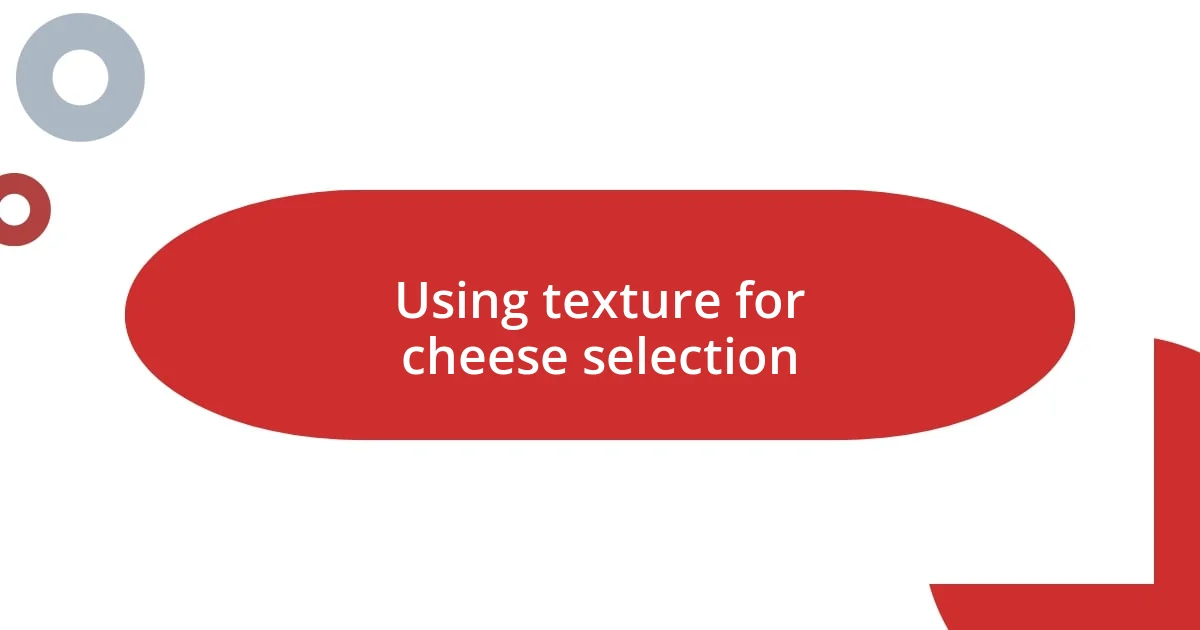
Using texture for cheese selection
When I’m selecting cheeses, I often consider their textures and how they interact with each other. For instance, I love the sensation of a rich, creamy brie paired with something crunchy, like toasted nuts. The contrast creates a delightful sensation that keeps each bite interesting. Have you ever found a cheese that feels silky smooth, only to be surprised by a crispy accompaniment that transforms the whole experience?
I vividly remember one evening where I paired a smooth camembert with homemade crackers. The crunchiness of the crackers complemented the cheese’s velvety texture, turning a simple snack into an unforgettable treat. The balance of soft and crunchy is so satisfying—it’s like a mini celebration in every bite. I’ll never forget that moment; it highlighted how texture can elevate the overall experience of cheese.
Another memorable pairing happened during a summer picnic where I combined a crumbly feta with sweet watermelon. The contrasts in texture—the creamy, fresh cheese alongside the juicy, tender melon—created a refreshing harmony that was as enjoyable as the sunny day itself. Isn’t it fascinating how something as simple as texture can evoke such joy and surprise in food pairings? I believe we often underestimate this aspect, but it can lead to truly delightful discoveries.
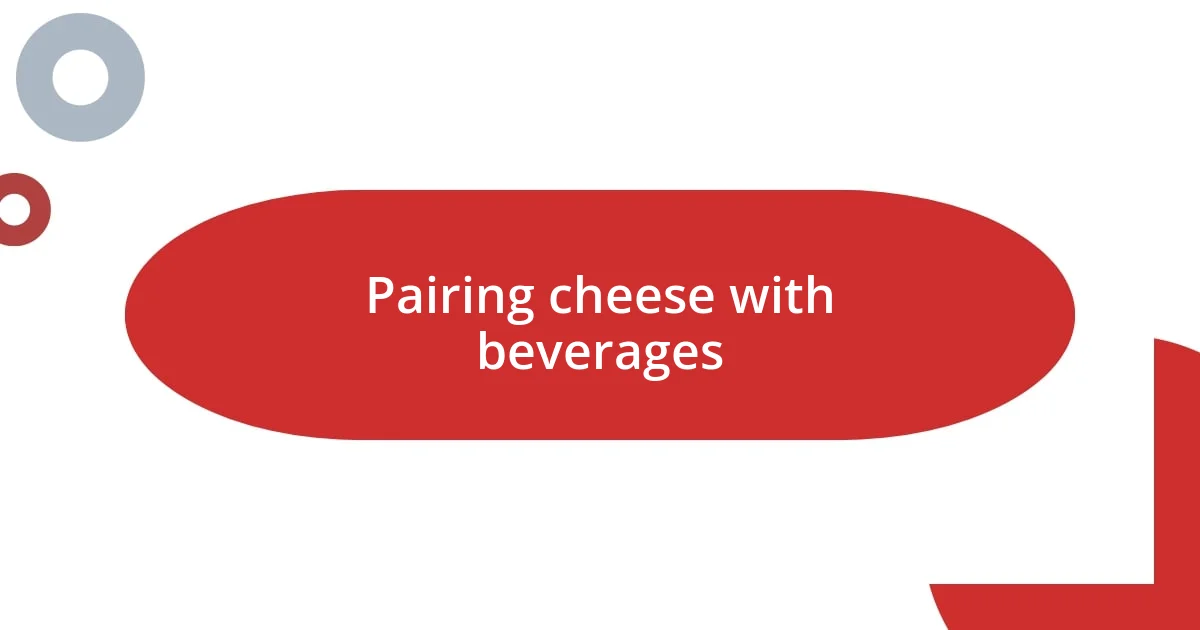
Pairing cheese with beverages
I love experimenting with cheese pairings and beverages—it adds an exciting dimension to my tasting experiences. One of my favorite combinations is a nutty aged gouda with a bold, malty beer. The beer’s richness balances the gouda’s caramel notes perfectly, creating a delightful sensory experience. I can still recall a cozy evening spent at a local brewery where this pairing truly shone; each sip and bite felt like a warm hug.
Wine, of course, is a classic choice for cheese pairing, but I’ve found that sparkling wines can elevate the experience even further. Imagine enjoying a creamy, tangy goat cheese while sipping on a crisp prosecco—the bubbles and acidity cut through the cheese’s velvety richness, clearing the palate for another bite. This pairing transported me to a sun-drenched terrace during a summer party where laughter flowed as freely as the beverages. Isn’t it amazing how certain drinks can enhance the flavors of cheese in such a profound way?
I also enjoy experimenting with unexpected pairings, like spicy cheeses with sweet cocktails. I once paired a peppery pepper jack with a fruity margarita, and it was a revelation. The heat from the cheese plays beautifully with the cocktail’s sweetness, creating a deliciously adventurous bite. Have you ever tried pairing flavors that seem opposite at first? Those experiments often lead to delightful surprises that heighten the joy of enjoying cheese!
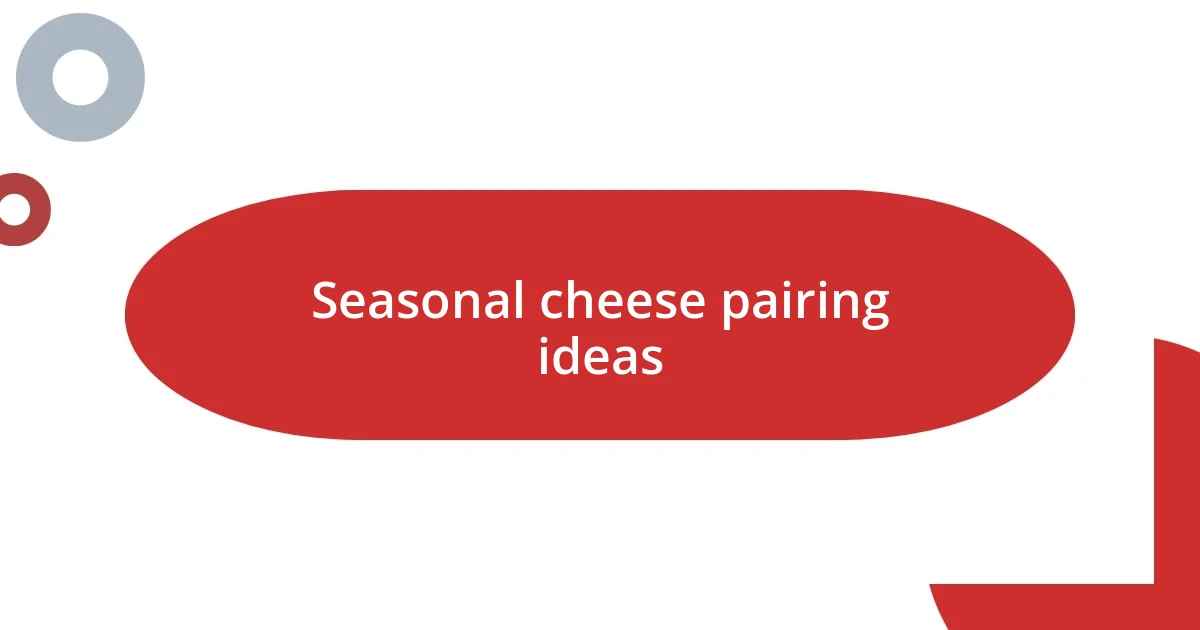
Seasonal cheese pairing ideas
As the seasons change, so does the potential for exciting cheese pairings. In the fall, I love to pair sharp cheddar with crisp apples, preferably those tart Granny Smiths. The crunchiness of the apple slices complements the rich, savory notes of the cheddar, creating a festive snack perfect for enjoying while watching the leaves change. Isn’t it wonderful when nature’s bounty inspires our culinary choices?
Winter brings a cozy vibe that calls for creamy cheeses like camembert or brie, served warm with spiced mulled wine. I recall a snowy evening spent gathered around the fire with friends, indulging in gooey brie topped with a drizzle of honey. The combination of flavors and the warmth of the drink make it feel like a comforting embrace. How can one not feel content in such a moment?
When spring arrives, I eagerly dive into lighter cheese options like fresh mozzarella paired with vibrant tomatoes and fragrant basil for a classic Caprese salad. I still remember discovering how the freshness of each ingredient complemented one another at a local farmer’s market. The bright flavors remind me of sunny days ahead and inspire a sense of joy and renewal. Have you ever noticed how seasonal ingredients not only enhance flavor but also evoke memories tied to specific times of the year?

Experimenting with unique combinations
Experimenting with unique cheese combinations has often led me to delightful surprises. I remember one evening when I decided to pair blue cheese with honey and walnuts. The sweetness of the honey contrasted beautifully with the cheese’s bold tang, while the walnuts added a satisfying crunch. Have you ever found flavor profiles that seem like an odd couple, only to discover they create something magical together?
One of my bold experiments involved pairing a creamy brie with fig jam and a slice of prosciutto. At first, it sounded unconventional, but the results were nothing short of extraordinary. The saltiness of the prosciutto balanced the brie’s rich creaminess, while the sweetness from the fig jam tied everything together. It reminded me of a picturesque picnic in the park, where the combinations danced on my palate, making every bite an adventure in flavor.
I’ve also dabbled in integrating spices that you wouldn’t typically associate with cheese. Recently, I tried a spicy smoked gouda with dark chocolate. The luxurious bitterness of the chocolate complemented the gouda’s smokiness, resulting in a pairing that left me pondering how flavors can evolve together. Have you thought about which unexpected elements could spark joy in your cheese experiments? Each taste can lead to a brand-new “aha” moment just waiting to be discovered.
